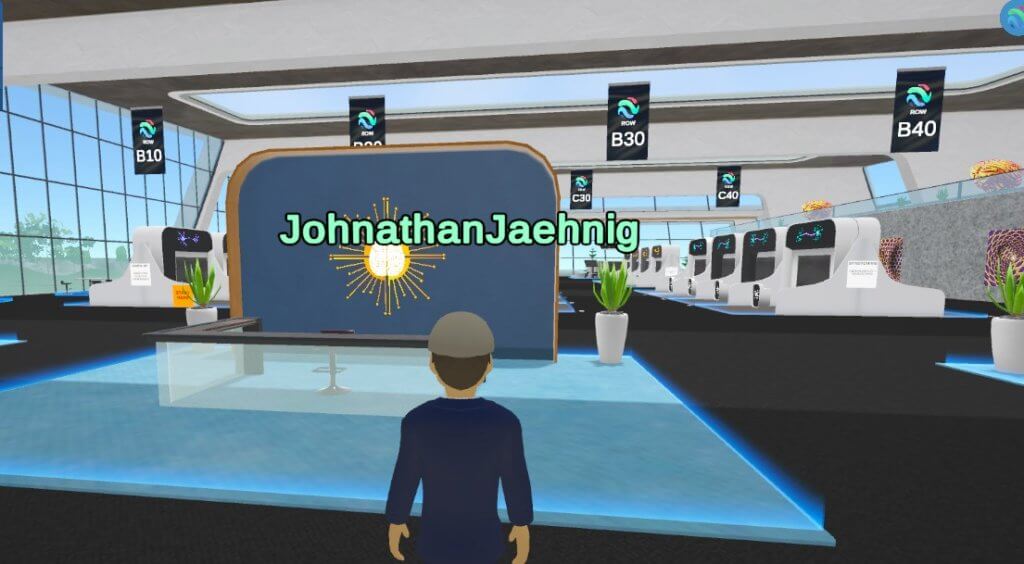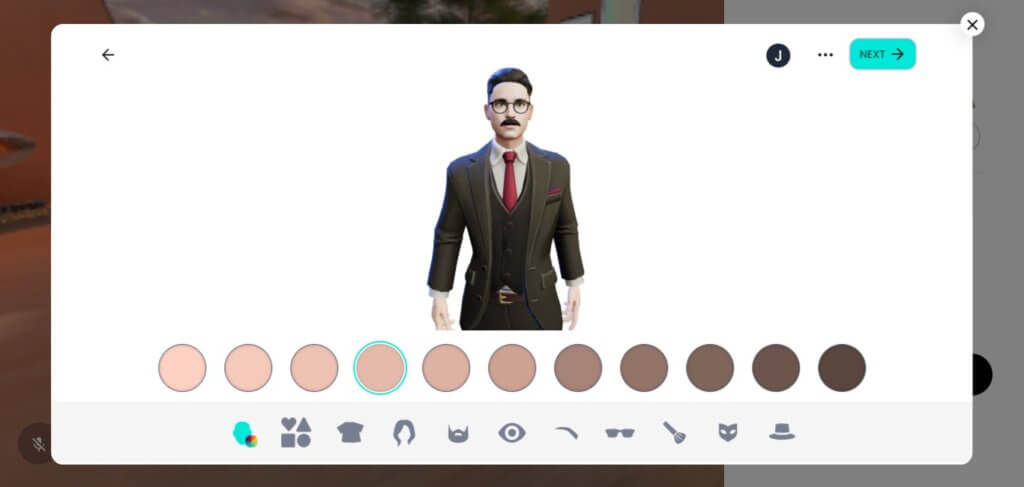Mental Health Awareness Month in XR

May is Mental Health Awareness Month, and there are plenty of XR applications and outfits that deserve highlighting. We’ve teased out a couple of projects and products that deserve a closer look.
Hit the Mind Gym in Virbela
Virbela is an enterprise-first solution focusing on remote work and events through the use of shared or custom virtual campus spaces. However, they’re also very community-focused and create special “islands” on their open campus for various causes.

In fact, their virtual library landed in our Black History Month roundup. This time, we’re highlighting a new experience, the “Mind Gym.”
“I was talking with a colleague about Mental Health Awareness Month and how we could handle that kind of thing at an enterprise level,” Virbela VP of Community, Sarah Segrest, told ARPost in an in-app interview. “We kind of thought about a mashup of futuristic exercises and a mid-century style gym.”
Modeled after a physical gym for your body, the Mind Gym is composed of over 60 different mental exercises, arranged from warm-ups, to “special equipment,” to cool-downs. The activities are embedded videos, JavaScript games, and other experiences, all accessible within Virbela.
“We wanted it to be challenging enough to be beneficial but easy enough to be fun,” said Segrest. “We intentionally had it be so much that you have to keep coming back.”
Speed up your executive function, put your memory through its paces, go through a guided meditation, or just take it easy and take in the beautiful sights and sounds of Virbela’s upgraded virtual campus.
During the tour of the Mind Gym, Segrest also took me to Virbela’s Virtual Sento. Modeled after Japanese communal baths, this is a space where visitors can come alone or together to de-stress to sounds and videos of nature.
“I kept coming back to this room,” said Segrest. “I haven’t gotten tired of it.”
Be Your True Self in Spatial
Spatial is another platform that isn’t necessarily dedicated to mental health (or health in general) but that is dedicated to supporting its users through inclusive spaces and representative avatars. In fact, the avatars just got more representative through an integration with Ready Player Me.
Spatial had been known for its photo-based avatar creation tool – which is still supported on the platform. However, since the company pivoted from enterprise to NFT art and metaverse events late last year, they have been exploring new avatar creation tools and found Ready Player Me to align not only strategically, but idealistically.
“I truly enjoy being able to feel like myself,” Spatial Director of Marketing Gianna Valintina said in an in-platform interview. “We have a global audience so it’s really important to us, allowing people to self-identify.”

In fact, the last time that ARPost covered Spatial was taking a look at their immersive gallery raising funds to support Ukraine through NFT sales. Valintina said that this is one of the prime examples of how users create welcoming, productive, and emotionally impactful spaces on the platform.
“I’m so grateful for the creators and people that come to us,” said Valintina. “It’s not just a space that you create for yourself, it’s a venue that you create for other people.”
A more customizable and inclusive avatar program isn’t the only thing that Spatial is doing to create a more human-centered platform. The site currently supports over 60 languages in real-time translation.
Explore Group Therapy in XRHealth
XRHealth is clearly dedicated to health and wellness. The company has been around for a while now, but they’ve primarily been involved in physical health. However, they’re starting to branch out into mental health, according to CEO Eran Orr, who spoke with ARPost in a recent video call.
Orr became interested in XR health after exploring it himself to recover from whiplash after a career as an F16 pilot. The company, which initially operated principally as a telehealth VR clinic, was one of the first XR companies to register with the FDA. They have since expanded their offerings and services for patients with autism, ADHD, and other conditions.
“The major shift happened two-and-a-half years ago when we decided not just to run those clinics but to offer our own VR clinics as well,” said Orr. “At some point, we realized that a specific application is not good enough … you need a holistic approach.”
The platform’s first non-physical therapy application was a group therapy room that can hold ten participants and a clinician moderator. This is only one of the mental health applications that will be available with XRHealth when it launches for the VIVE Flow, which Orr calls a “game-changer for mental health.”
“I believe that in the next five years the entire mental health market will shift,” said Orr. “You can hijack the mind to treat the body with VR.”
In addition to increasing acceptance of remote therapies among the general population, Orr believes that VR will revolutionize mental health for two main reasons. First, the software allows the clinician complete control over the experience, and second, the hardware allows quantifying outcomes.
Tend to Mind and Body With VZfit
Speaking of XRHealth, we also happened to speak to one of their partners, VirZOOM. More specifically, we spoke with COO Robert Collins and CEO and co-founder Eric Janszen. The company’s VR fitness platform, VZfit, allows users to race through the real world via Google Street View.
“Way back in 2015, we set out to find a way to use the power of VR to inspire people to get the exercise they need but couldn’t get themselves to do,” said Janszen, who is himself an avid cyclist. “Cycling is not just physical health, it’s how I do my meditating. It’s when I get my best ideas.”
The graphic component of the application has its benefits by allowing users to revisit real places that are meaningful to them or to explore the world from home. But, physical activity has a benefit for mental health as well.

“Talking about physical health and mental health as a combination, the more active you are, the more engaged you are, and the more it can help your mental health. You’re happier when you’re working toward a goal,” said Collins. “Our goal is that you don’t necessarily feel like you’re working out. You’re having fun and just happen to be burning calories.”
Users can also personalize their experience in ways that can be very meaningful to them. By creating their own routes, users have recreated trips that they took in real life, done memorial rides for past family members, and even gone on charity rides through Ukraine. The team is working on updates that will make the experience even more realistic.
Take a Mindfulness Course With Rendever
Rendever is devoted to mental health, specifically within senior living communities. And, like Virbela, the company put together a special initiative just for Mental Health Awareness Month. (Also like Virbela, the company had a Black History Month initiative that also landed a place in our BHM article.)
The initiative features an expansion of content and special sessions on their RendeverLive offering, which launched early in the pandemic. And, a friendly reminder that RendeverLive became available for subscribers outside of senior care facilities this winter. The platform had previously only been available to institutions.
“Today we offer daily and diverse live sessions that span travel, musical performance, book clubs, and more,” Rendever CEO Kyle Rand said in a blog post announcing the initiative. “We are celebrating Mental Health Awareness Month by doubling down on what we started last year. With this variety of mindfulness programming, the value of RendeverLive continues to build.”
The initiative includes on-demand chair yoga classes to encourage activity in the less-mobile populations. Mindfulness instructor Samantha Sebastian has also been offering live mediation sessions every weekday of the month.
Keep the Human Connection With Lumus
To top off the article with some food for thought, how will the XR experiences of other people affect your mental health? This is one of the questions that hardware manufacturers in particular are asking themselves as wearables spread from enterprise into our homes and onto our streets.
“We surprise ourselves with how adaptive we are. At first, it’s going to be a trickle … it’s going to be very fast that people accept it and move on,” said David Goldman. “At the end of the day, we’re all going to be living in a world with these devices.”
Goldman is VP of Marketing at Lumus, a company that makes displays for AR glasses. We spoke with Lumus about their displays this winter, and some of the topics were less about device stats and more about human behavior around these new devices. So, we reached out again to talk about life with wearable tech – which can look like wearing shades all the time.
Some AR glasses are tinted because it means that the display can be less bright. Some displays also result in “eye glow” which can let other people see what a wearer is doing, but can also be distracting and seem insincere when the wearer is communicating with other people. Lumus tries to do things differently for efficiency, but also out of sensitivity.
“Not only are we focused on the light leakage aspect, but we’re always trying to maintain eye contact,” said Goldman. “We think it’s critical that you can see the other person’s eyes.”
It’s not exactly in the Lumus wheelhouse, but Goldman is also interested in user interfaces – specifically gaze tracking and electromyography. Goldman calls these approaches “control without the crazy” because they don’t rely on verbal commands or outsized gestures.
Mental Health Is for All of Us
From manufacturers to enterprise spaces, to health platforms, to virtual galleries, mental health is at the forefront for most of the people making XR a reality. And it should be. XR is increasingly a part of how we work, relax, and take care of ourselves. It’s reassuring to see how such a wide spectrum of organizations are showing they care.
This article was originally published on arpost.co